

Strange loop. A strange loop arises when, by moving only upwards or downwards through a hierarchical system, one finds oneself back to where one started.
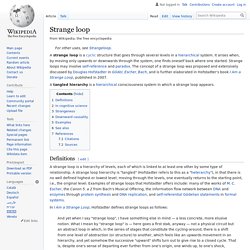
Strange loops may involve self-reference and paradox. The concept of a strange loop was proposed and extensively discussed by Douglas Hofstadter in Gödel, Escher, Bach, and is further elaborated in Hofstadter's book I Am a Strange Loop, published in 2007. A tangled hierarchy is a hierarchical consciousness system in which a strange loop appears. Definitions[edit] I Am A Strange Loop by Douglas Hofstadter. The 11.11.11. Gathering: Sedona.
2012 Stuff, For Sorting out junk. Heliospheric current circuit. From (The Plasma Universe Wikipedia-like Encyclopedia) Hannes Alfvén considered the heliospheric current sheet to be part of a heliospheric current system, as he believed all cosmic plasmas to be part of a "plasma circuit". [2] [3] The Sun behaves as a unipolar inductor producing a current that flows outwards along both axes B2, and inwards in the equatorial plane, C, and along Solar magnetic field lines B1.

The current closes at a large distance, B3. Properties Alfvén wrote: "The central body acts as a unipolar inductor and the e.m.f. is produced in region A. "In region B1 , the currents are field-aligned. "The model predicts that there should be currents near the axis strong enough to match the current in the equatorial plane. Galactic current circuit Notes. STB tek and pictorial - UPDATED - The Psychedelic Experience.
AFOAF sent me these pics and instructions.
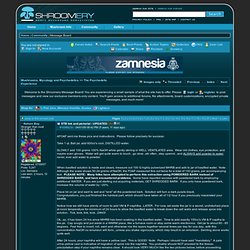
Please follow precisely for success: Take 1 qt. Ball jar, add 600cc's cool, DISTILLED water. SLOWLY add 100 grams 100% NaOH while gently stirring in WELL VENTILATED area. Wear old clothes, eye protection, and maybe even gloves. The Nexian DMT Handbook. The production and use of DMT (N,N-Dimethyltryptamine), otherwise known as "Spice", is a practice that resonates strongly with the complementary qualities of ancient shamanic and alchemical spiritual practice as well as contemporary DIY (Do It Yourself) ethic.
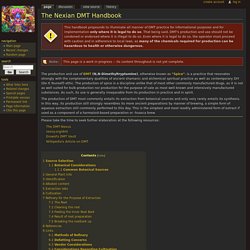
The production of spice is a discipline unlike that of most other commonly manufactured drugs, as it is not as well suited for bulk-production nor production for the purpose of sale as most well-known and intensively manufactured substances. As such, its use is generally inseparable from its production in practice and in spirit. The production of DMT most commonly entails its extraction from botanical sources and only very rarely entails its synthesis.
In this way, its production still strongly resembles its more ancient preparations by manner of brewing, a simple form of aqueous extraction still commonly performed to this day. Please take the time to seek further elaboration at the following resources: The Inspirator mkII. For further reference and discussion, see references:[2] The Inspirator mkII is considered by its designer to be the criterion of efficiency for vaporizing spice, and to be a cheap and effective method of achieving sufficiently cool, full, measured doses.

The device is inspired in part by The Machine but operates by convection heating--diffusing the heat through a ceramic heat-sink, in turn heating the airflow--rather than heating by conduction. This design was the final evolution of The Mini-Machine Bubbler Stem and the original version of The Inspirator. This particular model of the Inspirator utilizes a removable heating element to enable spice to be loaded into the top-side of the bowl, preventing the occurrence of run-off or drip.
The position of the element in relation to the plug also helps prevent overheating or burning by conduction, while the element itself serves to protect from exposure to the flame. Kolb. Mindfulness (psychology) Mindfulness as a psychological concept is the focusing of attention and awareness, based on the concept of mindfulness in Buddhist meditation.[1] It has been popularised in the West by Jon Kabat-Zinn.[2] Despite its roots in Buddhism, mindfulness is often taught independently of religion.[3][4] Clinical psychology and psychiatry since the 1970s have developed a number of therapeutic applications based on mindfulness for helping people suffering from a variety of psychological conditions.[5] Several definitions of mindfulness have been used in modern psychology.
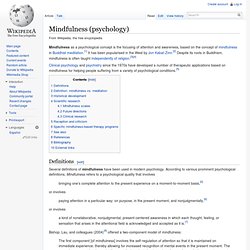
According to various prominent psychological definitions, Mindfulness refers to a psychological quality that involves bringing one’s complete attention to the present experience on a moment-to-moment basis,[6] or involves. Mindfulness-based cognitive therapy. Beyond its use in reducing depressive acuity, research additionally supports the effectiveness of mindfulness meditation upon reducing cravings for substances that people are addicted to.
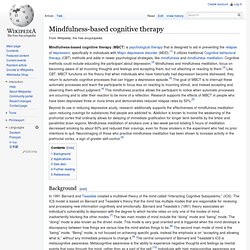
Addiction is known to involve the weakening of the prefrontal cortex that ordinarily allows for delaying of immediate gratification for longer term benefits by the limbic and paralimbic brain regions. Mindfulness meditation of smokers over a two-week period totaling 5 hours of meditation decreased smoking by about 60% and reduced their cravings, even for those smokers in the experiment who had no prior intentions to quit.
Neuroimaging of those who practice mindfulness meditation has been shown to increase activity in the prefrontal cortex, a sign of greater self-control.[6] Background[edit] In 1991 Barnard and Teasdale created a multilevel theory of the mind called “Interacting Cognitive Subsystems,” (ICS). Applications[edit] Mindfulness therapy is no fad, experts say. Of all fields of medicine, psychology seems especially prone to fads.

Freudian dream analysis, recovered memory therapy, eye movement desensitization for trauma — lots of once-hot psychological theories and treatments eventually fizzled. Now along comes mindfulness therapy, a meditation-based treatment with foundations in Buddhism and yoga that's taking off in private practices and university psychology departments across the country.
"Mindfulness has become a buzzword, especially with younger therapists," said Stefan Hofmann, a professor of psychology at Boston University's Center for Anxiety and Related Disorders. Mindfulness therapy encourages patients to focus on their breathing and their body, to notice but not judge their thoughts and to generally live in the moment. Games People Play (book) Games People Play: The Psychology of Human Relationships is a bestselling 1964 book by psychiatrist Eric Berne.

Since its publication it has sold more than five million copies. National Rainbow Gathering. 'Camp Cuddle Muddle Puddle' represented Pierce County at Rainbow Gathering.

Deep in the Gifford Pinchot Forest, tens of thousands of people held hands in a large mountain meadow after a morning of silence. Without assigned leaders or hierarchy, they started harmonizing an impressive 'Om' as a prayer for peace. When a children's parade bursted onto the scene full of color and music, the adults followed suit.
Egotism. Egotism is the drive to maintain and enhance favorable views of oneself, and generally features an inflated opinion of one's personal features and importance—intellectual, physical, social and other.[1] The egotist has an overwhelming sense of the centrality of the 'Me': of their personal qualities.[2] Egotism means placing oneself at the core of one's world with no concern for others, including those loved or considered as "close," in any other terms except those set by the egotist. Characteristics[edit] Egotism differs from both altruism - or acting to gain fewer values than are being given– and from egoism, the unremitting pursuit of one's own self-interest.
Various forms of "empirical egoism" can be consistent with egotism, but do not necessitate having an inflated sense of self.[7] Development[edit] Jiddu Krishnamurti. He claimed allegiance to no nationality, caste, religion, or philosophy, and spent the rest of his life travelling the world, speaking to large and small groups and individuals. He wrote many books, among them The First and Last Freedom, The Only Revolution, and Krishnamurti's Notebook. Many of his talks and discussions have been published. His last public talk was in Madras, India, in January 1986, a month before his death at his home in Ojai, California. His supporters, working through non-profit foundations in India, Great Britain and the United States, oversee several independent schools based on his views on education. Planetary Harmonics & Neuro-biological Resonances.
In Light, Sound, & Brain Wave Frequencies; Including the translation of sound to color Copyright © 2003-2014 Nick Anthony Fiorenza, All Rights Reserved New sections added: How to convert musical notes to color. Musical notes and Keyboard colors. Play Pythagorean vs. The Measurement of Light Converting Audio Tones to the Visible Spectrum of Light - Color. Feng shui. Feng shui ( Source Vibrations. What's New on Integral Naked. Scientific Proof of Reincarnation: Dr. Ian Stevenson. Twenty Cases Suggestive of Reincarnation: Second Edition, Revised and Enlarged (9780813908724): Ian Stevenson. Ian Stevenson. Mobile. Martin Seligman on positive psychology.